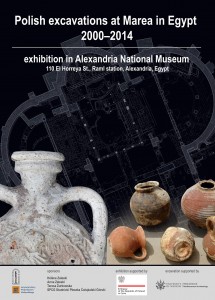Exhibition “Polish excavations at Marea in Egypt 2000–2014” presenting the results of 15 seasons of archaeological investigations at the site opened in the Alexandria National Museum.
The opening ceremony was led by the director of the mission, Krzysztof Babraj and the director of the Alexandria National Museum, dr Nadia Khadir. It was attended by representatives of the Polish Embassy in Cairo, officials of the Alexandria National Museum and a representation of the Alexandria Government. A short lecture about the site was presented by Daria Tarara, a long-term member of the Marea mission and author of the exhibition plates.
The exhibition consists of several plates depicting the history of the excavations and their results. They will be displayed in the main hall of the Museum for the next three weeks.
Marea/Philoxenite was a large port town located to the south-west of Alexandria. In the Ancient times it was famous, among other things, for its excellent wine which was sold in all parts of the Mediterranean.
Located on Lake Mariut near Alexandria, it was an important port in the Roman and Byzantine times, and probably existed already in the Ptolemaic times. As it was linked by canals to the Nile and the Mediterranean Sea, also products from Upper Egypt were brought there. The importance of Marea is evidenced by the four long piers, the longest of which (125 m) was built from strong stone ashlars bound with waterproof mortar.
Starting from 2003, the large Byzantine basilica of Marea has been excavated. The artefacts uncovered in it are dated from the late 5th till the early 8th century – the heyday of the town. Both the apse and part of the presbytery were built over a large pottery kiln. The kiln, one of the largest known in Egypt, is dated to the 2nd–3rd century AD. Two centuries later its grille was used by the builders of the basilica as the base for the apse.
Near the basilica a bath complex with a sakia was uncovered. To the south of the baths there are the ruins of a building identified as a burial chapel, dated, like the baths, to the 6th century.
Behind the apse of the basilica, in the north eastern part of the area, a complex of structures was discovered. They probably served as warehouses, shops, workshops, and living quarters. This is where the largest known concentration of ostracons bearing records of the works on the construction of the basilica, dated to the 5th–6th century, have been found.
The excavations in Marea have been conducted since 2000 by the Polish Centre of Mediterranean Archaeology, University of Warsaw and the Archaeological Museum in Cracow. Their first director was dr Hanna Szymańska until her death in 2010; since then they are headed by Krzysztof Babraj.
The exhibition was organized by the Archaeological Museum in Krakow and the Polish Embassy in Cairo in cooperation with the Polish Centre of Mediterranean Archaeology, University of Warsaw.



